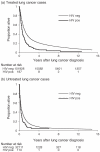Disparities in the treatment and outcomes of lung cancer among HIV-infected individuals
- PMID: 23079809
- PMCID: PMC3595594
- DOI: 10.1097/QAD.0b013e32835ad56e
Disparities in the treatment and outcomes of lung cancer among HIV-infected individuals
Abstract
Objectives: HIV-infected people have elevated risk for lung cancer and higher mortality following cancer diagnosis than HIV-uninfected individuals. It is unclear whether HIV-infected individuals with lung cancer receive similar cancer treatment as HIV-uninfected individuals.
Design/methods: We studied adults more than 18 years of age with lung cancer reported to the Texas Cancer Registry (N = 156 930) from 1995 to 2009. HIV status was determined by linkage with the Texas enhanced HIV/AIDS Reporting System. For nonsmall cell lung cancer (NSCLC) cases, we identified predictors of cancer treatment using logistic regression. We used Cox regression to evaluate effects of HIV and cancer treatment on mortality.
Results: Compared with HIV-uninfected lung cancer patients (N = 156 593), HIV-infected lung cancer patients (N = 337) were more frequently young, non-Hispanic black, men, and with distant stage disease. HIV-infected NSCLC patients less frequently received cancer treatment than HIV-uninfected patients [60.3 vs. 77.5%; odds ratio 0.39, 95% confidence interval (CI) 0.30-0.52, after adjustment for diagnosis year, age, sex, race, stage, and histologic subtype]. HIV infection was associated with higher lung cancer-specific mortality (hazard ratio 1.34, 95% CI 1.15-1.56, adjusted for demographics and tumor characteristics). Inclusion of cancer treatment in adjusted models slightly attenuated the effect of HIV on lung cancer-specific mortality (hazard ratio 1.25; 95% CI 1.06-1.47). Also, there was a suggestion that HIV was more strongly associated with mortality among untreated than among treated patients (adjusted hazard ratio 1.32 vs. 1.16, P-interaction = 0.34).
Conclusion: HIV-infected NSCLC patients were less frequently treated for lung cancer than HIV-uninfected patients, which may have affected survival.
Figures

References
-
- Engels EA, Brock MV, Chen J, Hooker CM, Gillison M, Moore RD. Elevated incidence of lung cancer among HIV-infected individuals. J Clin Oncol. 2006;24:1383–1388. - PubMed
-
- Nguyen ML, Farrell KJ, Gunthel CJ. Non-AIDS-defining malignancies in patients with HIV in the HAART era. Curr Infect Dis Rep. 2010;12:46–55. - PubMed
-
- Chaturvedi AK, Pfeiffer RM, Chang L, Goedert JJ, Biggar RJ, Engels EA. Elevated risk of lung cancer among people with AIDS. AIDS. 2007;21:207–213. - PubMed
Publication types
MeSH terms
Grants and funding
LinkOut - more resources
Full Text Sources
Other Literature Sources
Medical

